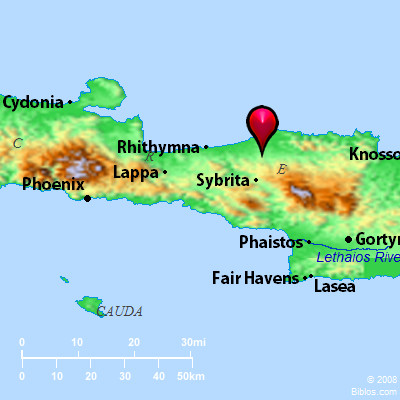Atlas  Caphtor (Crete) and surrounding area
Maps Created using Biblemapper 3.0Additional data from OpenBible.info
You are free to use up to 50 Biblos coprighted maps (small or large) for your website or presentation. Please credit Biblos.com. Occurrences Deuteronomy 2:23 and the Avvim, who lived in villages as far as Gaza, the Caphtorim, who came forth out of Caphtor, destroyed them, and lived in their place.) Jeremiah 47:4 because of the day that comes to destroy all the Philistines, to cut off from Tyre and Sidon every helper who remains: for Yahweh will destroy the Philistines, the remnant of the isle of Caphtor. Amos 9:7 Are you not like the children of the Ethiopians to me, children of Israel?" says Yahweh. "Haven't I brought up Israel out of the land of Egypt, and the Philistines from Caphtor, and the Syrians from Kir? Encyclopedia CAPHTOR; CAPHTORIMkaf'-tor, kaf'-tor-im (kaphtor, kaphtorim; Kappadokia, Gaphtorieim, Kaphtoriem).
1. First Theory: Crete:
The country and people whence came the Philistines (Genesis 10:14 = 1 Chronicles 1:12 (here the clause "whence went forth the Philistines" should, probably come after Caphtorim); Deuteronomy 2:23 Jeremiah 47:4 Amos 9:7). Jeremiah (loc. cit.) calls it an "island"; there is evidence of ancient connection between Crete and Philistia; and the Philistines are called Cherethites, which may mean Cretans (see CHERETHITES). These considerations have led many to identify Caphtor with the important island of Crete. It should be noted, however, that the word 'i, used by Jeremiah, denotes not only "isle," but also "coastland."
2. Second Theory: Phoenicia:
Ebers (Aegypten und die Bucher Moses, 130) thought that Caphtor represented the Egyptian Kaft-ur, holding that Kaft was the Egyptian name for the colonies of Phoenicians in the Delta, extended to cover the Phoenicians in the north and their colonies. Kaft-ur, therefore, would mean "Greater Phoenicia." But the discovery of Kaptar among the names of countries conquered by Ptolemy Auletes in an inscription on the Temple of Kom Ombo is fatal to this theory.
3. Third Theory: Cilicia:
A third theory would identify Caphtor with the Kafto of the Egyptian inscriptions. As early as the time of Thotmes III the inhabitants of this land, the Kafti, are mentioned in the records. In the trilingual inscription of Canopus the name is rendered in Greek by Phoinike, "Phoenicia." This seems to be an error, as the Kafti portrayed on the monuments have no features in common with the Semites. They certainly represent a western type. It is held that the Egyptian Kafto is a district in Asia Minor, probably Cilicia. The sea-pirates, the purasati, whom Rameses III subdued (circa 1200 B.C.), entered Syria from the north. The "R" in the name is the Egyptian equivalent of the Semitic "L". Therefore Purasati = Pilishti, "Philistines." And so it is proposed to identify Caphtor with Cilicia. A serious objection to this theory is the absence of the final "r" in Kafto. McCurdy's suggestion (HDB) that it represents a Hebrew waw, written as a vowel-letter in an original Kafto, does not carry conviction.
It is impossible to give a certain decision; but the balance of probability seems still inclined to the first theory.
W. Ewing Strong's Hebrew H3731: Kaphtorprobably a name for Crete |
    |




